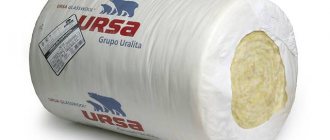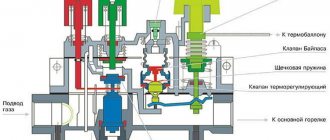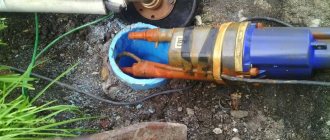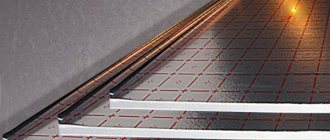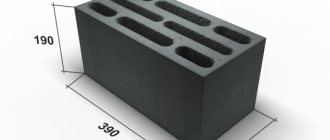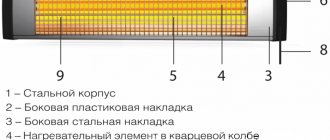Interest around heating rooms with infrared devices does not subside: some consider them ineffective, others consider them the most comfortable and economical.
Before choosing an infrared heater, you need to understand its technical characteristics and installation nuances, as well as get acquainted with the modern models on the market. Our article is devoted to these issues - here we will consider in detail the advantages of this type of heaters, highlighting the main varieties present on the market.
We will also consider the best models from well-known manufacturers, which users rated higher than others. In addition, the article is equipped with thematic photos and videos with recommendations for choosing the best heater for your home and apartment.
How the device works. The principle of operation of an infrared heater.
Professionals say that infrared heaters are an excellent source of heat in rooms. The operating principle of an infrared heater is based on the fact that electrical energy is converted into thermal energy through the heating process. Infrared thermal radiation heats external objects and organisms. The peculiarity of such devices is that 90 percent of the energy is spent on heating objects. And the remaining 10 are used to heat air masses. This is the main difference from conventional devices, the operating principle of which is the opposite. Conventional ones provide heating of the air in the room.
If infrared models are used in the room, the air is heated through the objects that are present in it. In this regard, heat loss in the room is minimized. This is the operating principle of an infrared heater.
It should be understood that if you add up the sum of the areas of all the objects that are in the room, it will be significantly higher than the area of a conventional battery. Based on the operating principle of an infrared heater, it can be said that it heats the room much faster than traditional heating devices, namely 4 times.
Another feature of such devices is that during their operation the difference in air temperature on the ceiling and floor is minimal.
What is an infrared electric heater? This device has its own structural features. Which ones exactly? Now we'll tell you. Each electric infrared heater has a housing. There is a control panel on it, and there is also a power cord that connects to electricity.
In addition, the device is equipped with a reflector. The latter can be of two types, namely cylindrical and parabolic shapes.
The infrared heater has special protection in the form of a mesh. The latter is made of metal. In addition to the mesh, the device can be equipped with a transparent partition.
Recommendations for choosing a heating device
Before purchasing, you have to decide: which model of infrared heater is better to choose for your own use? If you are interested in the option of an infrared carbon device, we recommend that you familiarize yourself with the varieties and tips for choosing a carbon model.
It is also necessary to determine where exactly the device will be installed, whether it is necessary to transfer it to another room, what heating area should be calculated, which power source is preferable for it.
Power is calculated in the standard way: 1 kW per 10 m², that is, to heat one room you will need a device no more powerful than 2 kW.
Image gallery
Photo from
Heaters for outdoor or terrace
Appliances for the kitchen or nursery
Mobile heating devices
IR equipment for garage
One of the indicators of the “longevity” of home heaters is durable materials and good build quality. Sometimes you can even judge by eye how reliable and functional a thing is.
If there are no nicks, chips or scratches on the body, all parts fit exactly to size, the grille is not deformed, adjustment is free - the product is of decent quality.
If unusual design comes first, the main focus is on wall-mounted electric models. Some of them are made so skillfully that they are difficult to distinguish from paintings or graphic works
Be careful with the cheapest models. Even if you are satisfied with the appearance, you need to look for a catch - perhaps it’s due to low-quality materials or the lack of any protection. Heater safety is one of the main criteria, for which you can overpay.
If the price is higher than usual, then the device is equipped with additional devices that may be useful. For example, a thermostat that controls the temperature, an overheat sensor or a remote control.
Types of heaters
There are many types of infrared heaters on sale. In addition, there are several classifications of such equipment.
Heaters by mounting method
Heating devices can be stationary and mobile. The latter variety is characterized by its compact size and minimal power. Stationary equipment will provide more efficient heating. Such models are divided into 3 groups.
Ceiling infrared heaters are considered the most convenient. They do not take up extra space and have a wide radiation range. Some models can be mounted directly to a suspended ceiling, while others are secured using brackets. In this case, a gap of 5 cm is maintained between the device body and the ceiling.
Floor-standing infrared devices are considered less powerful and efficient, since there are many obstacles in the way of study. When purchasing, you should give preference to a product with a tubular or carbon heating element. This is explained by the fragility of the ceramic variety, as well as the negative impact on the health of the halogen element.
Wall heaters are mounted directly on the wall
In this case, it is important to maintain a certain gap from the floor surface to the body. If desired, the device can be mounted directly under the window.
Types of devices by wavelength
Inside any infrared heater there are special heating elements. They all have different wavelengths.
- The long-wave emitter provides an operating temperature within 600˚С. Such equipment is installed not only in homes, but also in industrial or office premises where the ceiling height does not exceed 3 m.
- Medium wave radiation is provided by heating elements whose temperature ranges from 600–1000˚C. Accordingly, the ceiling in the room where such an infrared heater is located should have a height of 3–6 m. In most cases, these are country houses or various administrative buildings.
- Elements can emit short waves. which operate at temperatures above 1000˚C. In this case, the ceiling height must be at least 6 m. Accordingly, such heaters are used in factory workshops. They can also be installed directly on the street, but they are not suitable for home use.
Heating element type
When purchasing an infrared heater, you should always pay attention to the type of heating element
A halogen product is a halogen lamp that emits in the infrared range. Inside it there is a filament, for the manufacture of which carbon fiber or tungsten is used. During the heating process, infrared energy is released and transferred to the tube. This produces golden-colored radiation. To prevent it from irritating the eyes, the lamp can be treated with a special composition
It is important to remember that such heating elements produce short waves, and this can negatively affect human health. Accordingly, this option is not preferable.
The carbon variety is a quartz tube with a vacuum inside
This is where the carbon helix is located. The advantage of this element is considered to be quick heating and higher efficiency, however, the product will last only 2 years and will consume a lot of electricity. This option is not suitable for allergy sufferers and asthmatics.
Ceramic heating elements are protected, which means they will not glow during operation. Their service life is at least 3 years. Also, these products are more economical, and their price is relatively high. As a rule, such elements are used in saunas and various medical institutions.
The tubular elements are similar in design to the ceramic variety. Their price is higher, which is explained by reliability, ease of use and efficiency. The disadvantage is considered to be slight cracking caused by the difference in the temperature resolution coefficients of the spiral and the body itself.
Unusual but true
In exactly the same way, the Sun heats the Earth - with outgoing electromagnetic waves in the infrared range of light, which is indistinguishable to the human eye (for more details about the operation scheme, see the article on the principle of operation of a heater with infrared radiation).
IR waves have a beneficial effect on the body, a person feels pleasant relaxation and comfort; this type of thermal energy is more natural, as it is associated with sunlight.
Some users have expressed their concerns about the safety of the devices, comparing the energy they emit with high-frequency microwaves - microwave oven waves. However, tests carried out, as well as practical experience in use, have shown the absolute safety and efficiency of IR heaters, and given the advanced automation, even in an emergency, these devices are safer than similar heating installations. The main thing is to follow the installation and use rules recommended by the manufacturer.
What is the secret of popularity
Manufacturers declare the following advantages of infrared heaters:
- high efficiency and cost-effectiveness;
- absence of rotating parts and noise;
- a gentle warmth is generated that does not cause a deterioration in a person’s well-being;
- simple installation and connection.
As a rule, these are general phrases; something similar can be found in descriptions of oil radiators or wall-mounted convectors. They do not answer the question: why are devices so attractive to users in real life? It turns out that everything is simple, the operation of a ceiling infrared heater, like a wall-mounted one, is possible in non-insulated buildings, in drafts and even on the street. The main thing is to be within the range of infrared radiation.
A device that emits infrared waves will create a zone of comfortable heat in front of it, leaving the rest of the room unattended. It will warm up after a few hours from heated objects. But the fact remains: in a room where 1 kW of heat is needed for heating, people install a 500 W infrared heater so that the radiant heat is distributed as widely as possible. This creates the illusion of good heating, although in reality the temperature in the room remains dog-like; the laws of physics cannot be fooled.
The devices also have other disadvantages. For example, the design of an infrared heater in a suspended design implies a wasteful consumption of about 10% of the heat accumulating under the ceiling. This is a convective transfer of energy from the heated body of the device to the surrounding air, which remains there, under the ceiling. Various objects interfere with the operation of wall heaters; carbon and halogen heaters are annoying with their bright light, and micathermic heaters are expensive.
Best models
Various manufacturers in Europe and Russia produce home heating equipment. In this rating of infrared heaters, the best models that have collected positive customer reviews are selected.
1st place - Ballu BIH-AP4-0.8-W
The cost of this model is around 3000 rubles. This heater is designed to heat an area of 16 square meters, connects to a 220/230 V system and is installed at a recommended height of 2.4–3.5 meters, its power is 800 W.
Based on reviews, we find out that this is an effective and high-quality model that warms up the room quickly enough. The set includes durable brackets - with their help the device can be rotated. This model is mainly used as an additional source of heating in any room, but is also suitable for a garage and for installation outdoors - the waterproof housing will not allow rain to spoil it.
2nd place - Almac IK5
This infrared heating battery has a lower power of 500 W. It effectively heats 10 square meters, so in a single copy it is used as an additional heat source. However, three similar models can easily cope with heating a large living room or hall.
Judging by the reviews, the device effectively copes with its task, is easily attached to the wall or suspended from the ceiling, and is simply adjustable - it is enough to set 23 degrees during the day, 20 at night. The only drawback is the complexity of the connection. And although the instructions indicate how to install an infrared heater, the kit does not include wires and a thermostat, so without the appropriate knowledge and experience you cannot connect it - you will have to call a specialist, but you can turn a blind eye to this, given the low price of around 2,500 rubles.
3rd place - Peony Thermo Glass P-10 (7000 rubles)
The model is from the Russian one, which has become popular on the Russian market. Power – 1000 W, heating area – 20 m². The device is connected via a regular 220/230 V socket and is equipped with electronic control and a thermostat, which allows you to accurately regulate the power and heating temperature. It also received protection against overheating, which ensures minimal safety and increases its service life. The infrared heater can be installed on the ceiling at a height of 2.3–3.5 meters.
According to reviews, the model is effective: it quickly heats surrounding objects, operates silently and provides soft and pleasant warmth. This is an advantage, since some models heat aggressively.
The disadvantage is the equipment and high price. The model is significantly more expensive than similar heaters, and the kit does not include any cables. The device also needs to be looked after - if you do not systematically wipe the dust off it, then over time a burning smell will appear.
There are also many low-quality products on the market with the CE mark. In one case it means “Conformite Europeenne”, in the other it means “China Export”. Try to choose reliable equipment, since heating devices in the house always pose a certain danger.
Design and principle of operation of the heater
The design is based on the principle of propagation of infrared waves. Due to their large length, a person perceives only thermal energy. These heaters are divided into three types:
- electrical;
- gas;
- diesel
Operating principle of an infrared heater:
Electrical units
These IR heaters are considered the most popular, and they can most often be found in everyday life. The operating principle is based on heating emitters, which can be made of various materials, with electricity. In addition, these devices differ in the way they are located in the heated room.
Infrared heaters:
They can be floor-mounted, mounted on a wall or ceiling. Using ceiling equipment as an example, we can consider the operating principle of an infrared heater. It consists of the following parts:
- housings;
- tubular electric heater;
- radiating plate;
- thermal insulator.
Electric current passing through the heating element heats it. The tubular heater, in turn, transfers thermal energy to the radiating plate. And from it emanates directed radiation towards surrounding objects, which, when heated, give off heat into the air. Emitters can be made of different materials: carbon, ceramics, heat-resistant film.
What are the benefits of infrared heaters:
Gas and liquid fuel appliances
There are models of infrared heaters that use gas as fuel. They are mainly used for heating large rooms and outdoor spaces.
This procedure is possible due to the high thermal power of these heaters. Any gas is used, from natural to coke oven. To heat verandas and terraces, units made in the form of umbrellas are used.
The design of such a device includes a gas burner unit to which radiant pipes are connected. Some types of them work like simple gas burners, but they do not heat the surrounding space, but ceramic panels, which play the role of emitters.
Features of the infrared heater:
Specifications
Infrared heaters have different technical characteristics . Manufacturers are trying to improve both the emitter itself and additional functions. Additional options include, first of all, active safety systems, such as automatic shutdown in the event of an emergency or overload, operating mode in a system of interconnected devices, the ability to connect a thermostat or a smart home system for remote or completely autonomous control of the device.
Some models boast an elegant design and a thin front panel that will fit perfectly into any interior.
Built-in infrared film heaters
Glass infrared heaters
Let the infrared heater thank the birth of Sir William Herschel, who in 1800 discovered that in addition to visible radiation, the Sun emits something else. Experiments with a prism that split light into spectral components of different colors are known from the school curriculum. Projecting light onto the table, the scientist made a piece of cardboard with a small slit allowing only one through. Then he began to measure the temperature with a mercury thermometer. Imagine the surprise when, after the visible eye, heat was marked in red, where the naked eye did not detect anything! It became clear that man is gifted by nature with limited perception; energies circulate in nature that are not yet known to science.
In order for a body to begin to radiate, it is necessary to heat the object red-hot; a threshold of 500 ºС is considered sufficient. It is possible to obtain lower operating temperatures by increasing the working surface area (cold plasma glows at 26 degrees Celsius). Due to the mentioned effect, infrared glass ceiling heaters operate. Heated by a semiconductor element, the temperature is much lower than 500 ºС. For example, for Peony Thermo Glass it is 90 ºС. You can’t expect great speed, but the effect manifests itself instantly in the form of warm rays coming from above.
Infrared wall-mounted glass heaters Peony Thermo Glass are made in the form of colorful compositions with views of mountains and other landscapes. A transparent electrode is applied to the back of the glass, invisible to the naked eye. The next layer of the sandwich features a colorful painting, applied for aesthetic reasons. Finally, the back panel is insulated with ceramic or an alternative multi-layer material so that heat flows only in the front direction. As a result, a person viewing the Peony infrared glass heater feels a pleasant warmth on his face. Be careful, the temperature of the device is one and a half times (see above) higher than the permissible standards in Europe for central heating radiators. For a home with small children, a wall panel is not considered the best solution.
In the latter case, the Peony ceiling glass heater is suitable. The operating principle is similar, but the suspension point is located on the ceiling. The device resembles a fluorescent lamp. According to our information, the design is impact resistant, please check with your dealer for more details. Otherwise, it is better to take Peony Ceramics for the nursery, where there is nothing else except steel and clay firing products.
The worst thing that will happen is peeling of the working surface, which is hardly possible, given that the layer is applied to stainless steel using the micro-arc oxidation method with a thickness of a few microns. The impact load falls on the metal.
Please note that glass ceiling heaters are different from Pion Ceramics. The latter are made like fluorescent lamps, due to the thoughtful division of the working surface into two plates, turned at a slight angle outward
The first ones come in two types:
- An element of the Armstrong suspended ceiling, outwardly little different from the surrounding tiles, radiates heat. It is possible to equip the room with products during installation, or to make amendments to an already finished structure by carrying out modernization.
- Flat panels can be hung on the wall. They have a small height and do not stand out from the general background. We can say with confidence that visitors will not immediately understand that this is an infrared heater.
Peony products are suitable for all occasions. A wall-mounted glass heater with a landscape image will decorate the wall; it is better to hang it opposite the front door, not close to seated workstations, to avoid heat stroke. However, the warning concerns mainly older people; in young people it is difficult to predict the reaction in advance. Unlike ultraviolet radiation, infrared radiation is beneficial for the skin and underlying tissues. Penetrates to a depth of 5 mm into the skin, causing:
- improved blood circulation;
- acceleration of metabolism;
- strengthening regenerative function.
Dogs love infrared heaters, which means your employees will too. We believe that you can rely on the opinion of four-legged animals
Please note that due to the relatively low temperature, infrared glass heaters do not cause air ionization, but continue to shock-dry the microclimate. Therefore, in other situations, control and adjustment of the microclimate will be required.
For example, we will purchase additional convectors with built-in humidifiers.
pros
The undoubted advantages of infrared heaters are:
- excellent level of heat transfer with low heat or electric current consumption;
- a wide variety of appearance depending on the designers’ intentions;
- "soft warmth";
- maintaining normal air humidity;
- no smell of burning dust;
- relatively small area of the device;
- no need to store fuel reserves;
- almost complete absence of noise;
- ability to connect to a regular electrical outlet;
- mobility of technology.
But it is necessary to understand the positive aspects correctly - that is, not as absolute advantages. Thus, the efficiency of infrared heaters is manifested only with a competent approach. A lot depends on the correct selection of materials for the house and good thermal insulation. If mistakes are made in these moments, the efficiency of heating devices will not correct the situation. By the way, it is only slightly higher than the efficiency of conventional electric convectors.
Areas of application
Infrared heat emitters are ideal for heating use and can be used for:
- spot, zonal or general heating;
- halls, workshops, garages;
- outdoor work;
- restaurants and hotels;
- infrared saunas;
- SPA salons;
- shops and supermarkets;
- livestock farming;
- heating pools;
- winter and botanical gardens;
- heating of sports facilities and playgrounds.
Also, infrared heaters are increasingly used in everyday life and have firmly taken their place in houses and apartments. Due to their ease of operation, they are excellent for heating kindergartens, schools and other educational institutions. Often used for large-scale concerts and other outdoor events. They can be seen in the open areas of bars and restaurants - where other types of heaters are powerless.
Buyer mistakes
When choosing products, buyers make the mistake of not paying attention to the thickness of the anodized coating of the heat-radiating plate, indicated in the accompanying documents. It becomes covered with a “web” of cracks with a thickness of less than 25 microns, and budget models with layer thicknesses of less than 15 microns last 2–3 years, turning into a regular stove after the layer burns out.
It is preferable to choose models with a protective mesh or screen if there is a possibility of subsequent contact with the electrical appliance by children and animals.
Infrared household appliances have undeniable competitive advantages. While oil radiators and convectors heat up after being plugged in after 30 minutes, the thermal effect from infrared units is felt almost instantly. Despite the higher cost compared to analogues, infrared product items will be a profitable purchase for those buyers who value high efficiency, directivity and speed of heating, and quiet operation.
Radiation intensity
When choosing infrared heating, you need to be careful with the power of the device. Normally, it should not exceed 350 W per square meter. If the radiating element is not heated above 100°C, then the surface of the heated objects will not be above 35°C. Properly designed and installed IR heaters can distribute heat evenly throughout the home, creating a comfortable microclimate.
Powerful infrared heating over a long period of time is dangerous for the skin and eyes. But household IR devices are adapted and the spectrum is configured for human use in residential conditions.
Classification of infrared heaters
All IR heaters existing today can be classified:
By radiation range
Depending on the wavelength emitted, infrared heating systems can be:
- Shortwave. Waves with a length from 0.74 to 2.5 microns. They operate at temperatures from 100°C. The required ceiling height is from 6 to 8 meters. Short-wave devices are energy-consuming and burn oxygen, so they are rarely used for heating residential premises. The main area of application is heating of industrial premises.
- Medium wave. Wavelength from 2.5 to 5.6 microns. Heating temperature from 600 to 1000°C. Ceiling heights from 3 to 6 m.
- Long wave. Wavelength ranges from 5.6 to 100 microns. Operating temperature 100 - 600°C. The recommended ceiling height is up to 3 m. Such models are most often used in everyday life, due to the insufficient heat flow production for large rooms.
Differences between convection heating and infrared heating
By emitter type
The design features of IR heaters quite often depend on the type of heating element used in the models. The following varieties are distinguished:
- quartz;
- halogen;
- carbon;
- heating element.
Each of the elements presented above has its own efficiency, emits a certain wavelength and spectrum of visible light. These parameters will be discussed in detail below.
By energy source
- Electric ones are most often used in everyday life. They are easy to use, compact and have a fairly long service life.
- Gas models are characterized by fairly high power and impressive dimensions. They work on the same principle as electric ones. To be fair, it is worth noting that today on the domestic market there is a large assortment of compact gas IR heaters that use liquefied gas as a source of thermal energy.
- IR heaters running on diesel fuel are used in production and construction sites in various technological processes. The power of such devices is comparable to gas installations.
- In water IR heaters, hot water and the heating system act as a radiation source. Infrared water heating panels are quickly installed and can be used in any room.
Advice! To heat your home, it is better to use electric models, which are quite compact, safe, durable and have an optimal price-efficiency ratio.
By installation method
According to the installation method, IR heaters can be:
- Stationary. There are wall, ceiling and baseboard models. They can be suspended mounted, attached to a plane, or built-in.
- Mobile or portable. Typically these are floor-standing models. They are characterized by low power and dimensions.
Devices with ceiling placement are considered the most convenient. They do not take up any useful space in the room and have a wide radiation zone. While the power is similar to ceiling models, wall-mounted installations are less efficient, since they are directed strictly at one point in space.
Very similar in characteristics to wall-mounted models, floor-mounted models. Thanks to the rotating “leg”, the emitter can be directed in different directions, heating specific areas of the room.
Absorption
Infrared radiation can be reflected, absorbed and conducted. There is a simple arithmetic relationship between these 3 stages that adds up to 1 or 100%. 1 or 100% is otherwise called an absolute black body. A completely black body is a physical body that, at any temperature, absorbs all electromagnetic radiation incident on it in all ranges. Thus, an absolutely black body has an absorptivity of 1 for radiation of all frequencies, propagation directions and polarizations.
Radiation = Reflection + Absorption + Transmission.
Infrared lamp heaters
Let's consider lamp infrared heaters; the operating principle of the devices imitates the Sun. The suborder includes many devices, for example, halogen ones. The principle of operation is concentrated in the fact: a nichrome spiral wound on a heat-resistant ceramic core fits in an inert gas environment. Under the influence of a passing current, an effect described by the Joule-Lenz law occurs. The amount of heat depends on:
- stresses at the ends of the spiral;
- material resistance;
- current duration.
It is clear that nichrome, which has solid resistance, was chosen to enhance the effect. The spiral heats up gradually until red hot. The thread begins to emit in the infrared range. To glow, the body is heated to a temperature of 500 ºС. The coil heats up even higher. The radiation passes through the inert gas without large losses and reaches the glass bulb of the heater lamp. The material for the part is an alloy of quartz sand, which selectively transmits waves in the operating range. Energy losses in infrared heaters are zero.
Then the radiation goes out into the room
Please note that most heater lamps are symmetrical about the axis. Therefore, the radiation is equivalent in power for any direction
To correct the deficiency, an infrared lamp is placed at the focus of a special mirror reflector. The most common material is stainless steel. Ideally, silver applied to the back of the glass (mirror) is better. However, the proposed option is too expensive and fragile, which will not allow the production of relatively cheap infrared heaters.
The dead zone is concentrated in the center, covered by the lamp body. Such little things do not detract from the advantages of infrared heaters; the efficiency of the devices is high. The lamps would work with a vacuum pumped inside. True, the mentioned technical solution demonstrates two disadvantages:
- The lamp becomes fragile and the object will be affected by atmospheric pressure. The glass walls will have to be made thicker, which will reduce the efficiency of the device and increase the cost.
- In a vacuum, the spiral will begin to evaporate. Have you ever wondered why the liquid Sun at a temperature of 6500 Kelvin does not scatter throughout outer space? There the forces of gravity are shown in action. On Earth, the force of gravity prevails; in vacuum conditions, atoms will begin to leave the hot spiral, which will lead to breakdown of the device. According to some information, stray particles settle on the glass, which will inevitably cause a decrease in efficiency. A mirror surface will begin to form, which is not needed on a transparent shell. Special additives and inert gases greatly reduce the speed of the described process and even help the atoms return back.
Therefore, the infrared heater lamp inside is filled with a special inert gas. The method reduces efficiency; the transmission spectrum of halogens is selected so as to minimize useful radiation. The layer of gas inside the lamp is small compared to, say, the atmosphere.
It turns out to be a real sun that does not heat the air, but gives off heat to bodies. Ceiling-type lamp infrared heaters are good in the bedroom and kitchen. To prevent the bed and the air from feeling cold (20 ºС is the temperature at which doctors recommend falling asleep), equip the room properly. The emphasis of the power flow falls on the legs of a lying person.
Emissivity of various materials
Polished aluminum 0.09. Polished brass 0.03. Polished bronze 0.10. Carbon (Candle Soot) 0.95. Ceramics (glazed porcelain) 0.92. Polished chrome 0.10. Concrete 0.85. Polished copper 0.02. Oxidized copper 0.65. Quartz glass 0.75. Polished iron 0.21. Rusty iron 0.65. Matte plastic 0.95. Polished silver 0.05. Polished stainless steel 0.16. Oxidized stainless steel 0.83. Water 0.96.
Using this law, we can calculate the net heat exchange between two sources of infrared radiation T1 and T2. As a consequence, the net heat transfer will be equal to the difference in thermal radiation between the two sources.
Planck's formula describes the spectral distribution of the radiation energy of an absolute black body in thermal equilibrium at a certain temperature. The law is named after Max Planck, the German physicist who proposed it in 1900.
If we apply this law for different temperatures, we can calculate:
1. The range of frequencies in which heat is generated. 2. Emission power at a certain wavelength.
Design features
What is an outdoor infrared heater running on gas? This is a vertical installation consisting of:
- A cylindrical body in which a liquefied gas cylinder is hidden.
- A metal stand with a hose connecting the cylinder and the burner device.
- Round meshes. The control unit is mounted on it, and the gas burner probe is mounted on top.
Gas from the cylinder enters the burner. There it is ignited by a piezoelectric element. When burned, the gas greatly heats up the grid, and it begins to emit infrared waves. They are reflected from a special reflector and directed downward, heating all objects located in the wave propagation zone.
Depending on the model, the heated area may be different. The more powerful the device, the wider its range of action. The heat generated by the heater is completely harmless to humans. A lot of scientific experiments were carried out that confirmed this fact.
Power consumption and electricity consumption
Classification by power is directly related to the distribution of heaters over the area of the heated space. If the device consumes from 0.1 to 0.4 kW of current, then this is a so-called “soft heat” device. The operating temperature will be a maximum of 60 degrees Celsius. It is permissible to operate heaters of this kind even in bathrooms and other particularly damp places. They are also recommended for children's rooms, educational and medical institutions (due to maximum safety).
IR heaters with a power of 0.4-0.6 kW warm up to 60-100 degrees. The vast majority of such equipment is intended for office buildings. Some models are equipped with Armstrong ceiling mounts. External housings are always made of metal. The level of electrical protection can vary greatly, ranging from IP21 to IP55.
The most powerful devices consume from 0.6 to 1 kW. The working part warms up from 101 to 280 degrees. Such equipment is produced by a variety of manufacturers. For the most part, these are thermal curtains that reliably stop the penetration of cold air from the street.
(no votes yet)
Terms used to measure heat
Heat is a type of energy that is measured in Joules (J) or BTU (British Thermal Unit) . The joule is a unit of measurement used in thermodynamics. BTU is more commonly used even in the US, despite its name. Calories are very rarely used in thermodynamics. Heating power is measured in Watts (W) and is calculated as 1J/sec. Heat flux (Φq) is calculated as a unit of power per unit area and is measured in W/m² or W/cm² .
Although temperature can be measured in a variety of units, the most commonly used in industry is degrees Celsius (°C) . However, Kelvin (K) is used for scientific purposes as it helps make more accurate measurements, while Fahrenheit (°F) is mainly used in the USA.
